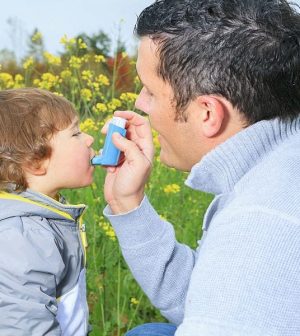- Skip Storing This Everyday Product in the Fridge Door
- Green Tea + B3 Pairing May Boost Brain Health
- Navigating Your Midlife Crisis: Embracing New Possibilities
- City Raccoons Showing Signs of Domestication
- Mapping the Exposome: Science Broadens Focus to Environmental Disease Triggers
- One Week Less on Social Media Linked to Better Mental Health
- Your Brain Changes in Stages as You Age, Study Finds
- Some Suicide Victims Show No Typical Warning Signs, Study Finds
- ByHeart Formula Faces Lawsuits After Babies Sickened With Botulism
- Switch to Vegan Diet Could Cut Your Greenhouse Gas Emissions in Half
Preschoolers’ Parents May Be Unprepared to Treat Asthma

Only about half the parents of asthmatic preschoolers had the right knowledge and medicines on hand to treat their child’s breathing condition at home, a new study found.
And one-third of those children had empty inhalers, the researchers reported.
“The inability to treat asthma could lead to emergency department visits,” explained senior study author Michelle Eakin, an associate professor at Johns Hopkins University School of Medicine in Baltimore.
“We asked to see children’s asthma medications [on a home visit] and only 60 percent had the child’s rescue medication ready,” she said. Having the medication “ready” meant having it in the house, ensuring it wasn’t expired and making sure it wasn’t empty.
Asthma is the most common chronic health condition in children in the United States. It’s also a major factor in health disparities in the United States. Sixteen percent of black children have asthma, compared with 7 percent of white children, the study authors noted.
Symptoms of asthma include coughing — especially when it’s worse at night — wheezing, chest tightness and shortness of breath, according to the U.S. National Heart, Lung, and Blood Institute. Untreated asthma can make it very difficult to breathe, and in the most severe cases, can lead to death.
Treatment for the disease includes “rescue” medication, such as albuterol (ProAir, Ventolin), which is given when symptoms such as wheezing are active. There are also controller medications, especially corticosteroid inhalers like Flovent, Pulmicort and Qvar. These are used daily — even if a child has no symptoms — to keep the inflammation that causes asthma symptoms at bay, the NHLBI says.
In collaboration with the Baltimore Head Start early childhood education program, the researchers interviewed the caregivers of nearly 300 children during a 2-hour home interview. The kids were aged 2 to 6 years (average age 4), and almost two-thirds of them had uncontrolled asthma.
Ninety-two percent of the families were black. The same percentage of the caregivers were one of the child’s birth parents, usually the mother. Forty percent of the caregivers hadn’t finished high school, and one-third had attended college or graduated from college.
The researchers were looking for five specific factors that indicated caregivers were ready to treat a child’s asthma:
- Availability of the medication — could parents easily locate it?
- Was the medication expired?
- Did it have a counter to indicate remaining doses?
- Was it a “rescue” drug or a controller medication?
- Did parents know dosing instructions?
Of the parents who reported their kids using rescue medication, only 60 percent met all five criteria, and only 79 percent had the medication at home. Among parents whose youngsters needed controller medications, only 49 percent met all five criteria, and only 79 percent had it in the home, the findings showed.
On the issue of expired medications, Eakin explained that because inhalers use propellant to deliver the active medication to the lungs, it’s possible that there may still be propellant available even when the drug has run out. That means it feels the same to the person using it. But if the counter on the outside of the inhaler is at zero, there is no active medication.
Since almost all of the children had state health insurance that usually includes only a nominal co-pay for inhalers — usually about $1 — cost probably wasn’t a factor for the parents interviewed, Eakin noted.
Education about asthma and the different types of education may be lacking, Eakin suggested.
Dr. Jennifer Appleyard, chief of allergy and immunology at St. John Hospital and Medical Center, in Detroit, said the study is a “wake-up call.”
“I don’t think this is just in preschoolers or in African Americans or in inner-city kids, and I don’t think this is all on the parents either. I think this study’s findings can be extrapolated to all age groups,” Appleyard said.
“We need to reinforce education at every appointment, and we need to ask, do you have your inhalers? Are they expired? Do you know the proper technique?” she added.
Appleyard said that in her practice, parents are given medication instruction sheets at every visit. “There’s a lot of information. It gets overwhelming for patients and parents, but we have to make sure they understand the disease and their medications,” she said.
“The more the patient [and parents] understand the disease, the more compliant and better-controlled they are. But that takes time and resources,” she explained.
The study was published online Aug. 7 in the journal Pediatrics.
More information
Learn more about asthma and its treatment from the U.S. National Heart, Lung, and Blood Institute.
Source: HealthDay
Copyright © 2025 HealthDay. All rights reserved.










